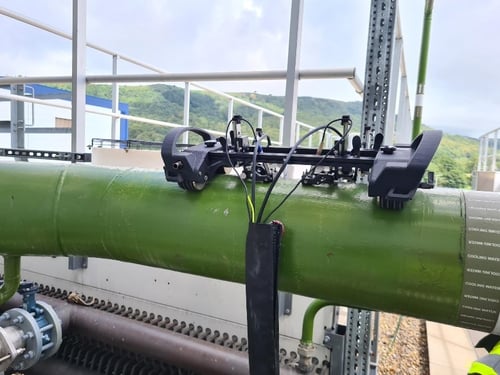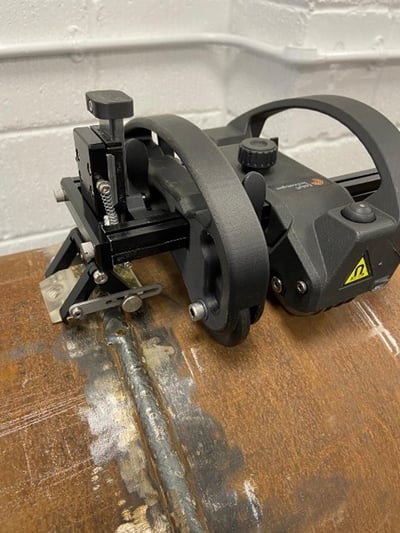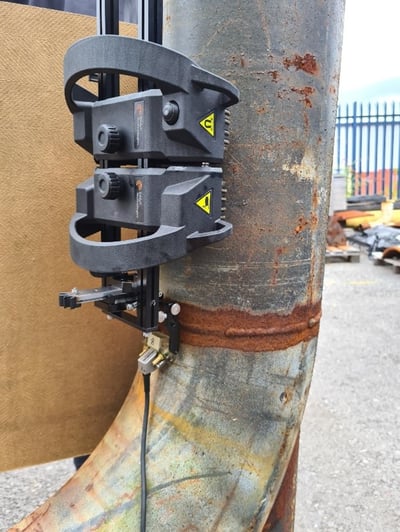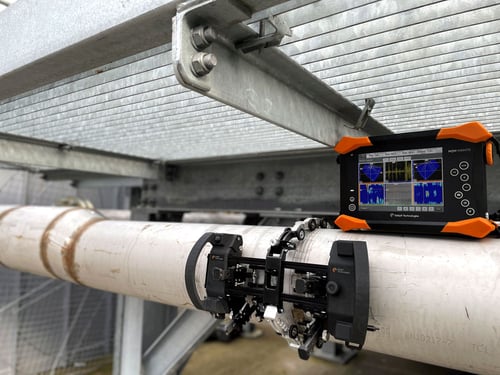During the initial introduction of automated UT methods, the primary focus was on pipe-to-pipe welds with suitable access for two-sided scanning.
Phased array ultrasonic testing, or PAUT, and time-of-flight-diffraction, or TOFD, were quickly accepted as suitable alternatives to radiography and are now regarded as mature technology for standard configuration welds.

Figure 1: Conventional pipe-to-pipe weld with access to both sides
While asset owners have benefitted from reducing radiography for onsite activities, there has been an increase in requests to introduce PA/TOFD for all variations of welds. Eddyfi Technologies’ instrumentation is capable of creating code compliant focal laws for a variety of different weld configurations, and now with the introduction of LYNCS™ WI, we can offer a turnkey solution for previously difficult-to-inspect welded joints.
Pipe-to-fitting welds
Many straight sections of pipe are not welded to other straight sections and can often form a joint at pipe elbows, flanges, or even fittings. When testing volumetric butt welds, it is important to interrogate both fusion faces at optimal angles or with UT methods, such as TOFD, that are not affected by the orientation of the defects. When testing complex weld joints as previously named, a common method to use is phased array on one side of the weld followed by a TOFD setup to inspect the fitting side fusion face. To perform this inspection, the LYNCS WI scanner mounts all required PA/TOFD probes and is mechanically configured for the available scanner surfaces. The image below shows the recommended arrangement for weld inspection at elbows.

Figure 2: Restricted access scanning with dedicated TOFD scan for far side fusion face assessment

Figure 3: Pipe-to-elbow weld one sided inspection using phased array and modified LYNCS scanner
Austenitic welds
Austenitic welds were historically regarded as problematic for ultrasonic testing. The coarse grain structure of the welds, coupled with the change in grain structure at the weld boundary was often considered too attenuative to achieve a reliable signal-to-noise ratio. However, with improvements in instrumentation, Capture™ software features, and the use of dual matrix array (DMA) probes specifically designed for austenitic welds, PA is now a reliable solution for this type of joints. The recently launched LYNCS CHAIN is the perfect scanning solution for this type of pipe joints. As austenitic material is non-ferrous, traditional magnetic scanners are not practical. Adding the LYNCS CHAIN accessory provides the user with all the established benefits of the LYNCS scanner without requiring magnetic adhesion. The chain provides maximum accuracy for probe placement and fully recordable data sets for weld coverage.

Figure 4: Stainless steel inspection using two DMA probes and creep weld inspection
The new age of plastic piping
High density polyethylene (HDPE) piping is an increasingly popular alternative to traditional steel pipes as detailed here. Much like the mechanical restraints of stainless steel pipes, plastic pipes are also non-ferrous and require a scanning mechanism that provides a high degree of accuracy for probe positioning. However, unlike with stainless steel weld inspection, it is common practice to use a straight beam probe for HDPE. For electron fusion joints, the preferred method of inspection is using a straight zero-degree beam with a water jacket and scanning directly over the joint. This type of welded joint is also perfectly suited to LYNCS CHAIN, this time housing the Eddyfi Aqualock probe with portable water column. This is one of the key strengths of the LYNCS family of scanners. With toolless operation and versatile adjustments, the same scanner can be used in a wide range of applications by simply selecting the correct PA/TOFD probes for that application. It doesn’t get any better than that!
Conclusion
Radiography certainly has unique benefits for some NDT applications, however more often than not, asset owners are making use of the significant cost savings and safety improvements offered by adopting advanced UT. The challenges for complex joints, coarse grain structure material, and non-ferrous scanning surfaces are gradually being overcome. The power performance of Eddyfi Technologies’ PAUT instruments featuring the best-in-class intuitive workflows of Capture software paired with the vastly versatile LYNCS scanning family had made difficult weld inspection a thing of the past.
Contact our team of experts to learn how to optimize your next inspection campaign and stay Beyond Current!





